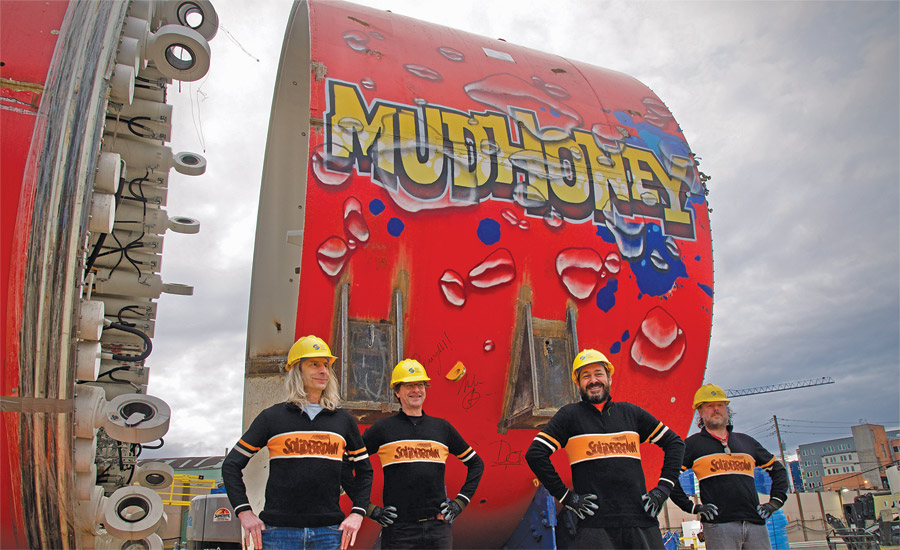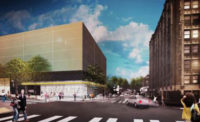Superlative-filled tunnel-boring machines are nothing new to Seattle. From the infamous mole that dug a new State Route 99 tunnel to a handful of TBMs carving a new path for Sound Transit’s aggressive light rail expansion, tunneling under the Pacific Northwest city is almost commonplace.
But in no tunneling experience in Seattle—or anywhere else in North America, for that matter—has a TBM run into a boulder the size of the one hit by MudHoney, a 21-ft, 8-in.-dia machine digging a 2.7-mile, 18-ft, 10-in. internal-diameter tunnel from the Seattle neighborhoods of Ballard to Wallingford.
The $570-million Ship Canal Water Quality Project is a joint effort between Seattle Public Utilities and the King County Wastewater Treatment Division that, when complete, will collect and hold up to 30 million gallons of stormwater and sewage flows that would otherwise overflow into Seattle’s Ship Canal waterway.
The heart of the project is a 2.7-mile tunnel that will be fed by five vertical shafts that collect stormwater and sewage flows and send them 40 to 80 ft below ground. The project also includes two additional 8-ft-dia tunnels and a rail system used to haul the mined material and bring in tunnel segments.

Crews craft a segment build behind the MudHoney TBM. Every 5 ft of boring translates to stopping to install a concrete ring.
Photo courtesy Seattle Public Utilities
Hard Rock
The TBM handling the job was named after the seminal Seattle grunge band Mudhoney in an online vote. The earth pressure balance pressurized face tunnel-boring machine was manufactured in Germany in 2020 and began its work the following year.
MudHoney features a 31-ft, 2-in.-long shield and 18 double-disc cutters, 48 scrapers and 16 bucket cutters on the cutterhead. Crews of 10 to 15 operate the TBM in both a control room and inside the front of the TBM. Every 5 ft of boring translates to stopping to install a concrete ring, like how crews traditionally construct Sound Transit tunnels.
The TBM should wrap up its underground journey by summer 2023, but no thanks to the boulder it hit along the way.
“What made this boulder unique, other than its size, was its strength.”
—Fabrizio Fara, Project Director, Lane Construction
That boulder in question extended up to 12 ft in diameter and ran 10 ft long. “What made this boulder unique, other than its size, was its strength,” says Fabrizio Fara, Lane Construction Co. project director leading the tunneling, “with a portion of the boulder above 47,000 psi in unconfined compressive strength.”
When the TBM hit the boulder, the cutterhead was “significantly damaged.” The cutting tools were replaced in hyperbaric conditions and structural damage to the cutterhead was also repaired. “Most of the damage was in the front side of the head, meaning that all repairs were to be carried out from outside the cutterhead,” Fara says.
Lane Construction designed, planned and performed the excavation of a rescue box, approximately 50 ft below ground surface. The niche was excavated by hand from inside the TBM cutterhead, and the miners and mechanics were able to access and complete the structural repair of the TBM. A “substantial ground improvement campaign was performed prior to excavating the work cavern to ensure stability of the ground throughout the repair.”
The team successfully completed boring through the boulder in May 2022.

Crews spread fill material in the base of one of the shafts that will carry sewage and stormwater into the new storage tunnel.
Photo courtesy Lane Construction
Overflow Alternative
Since the 1800s, more than 150 tunnels spanning over 70 miles have been constructed in Seattle for sewers, utility corridors and transportation needs. The latest tunnel comes as Seattle and King County must comply with federal and state authorities to reduce pollution from combined sewer overflows.
In the current design, both stormwater runoff and sewage run through the same system in the neighborhoods the project hits—Ballard, East Ballard, Fremont, Queen Anne and Wallingford—resulting in the potential for heavy rains to exceed system capacities and spill untreated sewage into public waterways. By diverting overflows—typically about 90% stormwater and 10% sewage—into the new shafts, the storage tunnel will reduce overflow pollution by more than 75 million gallons annually.
Fara says most of the tunnel runs through glacial till material, comprised of dense mixed clay, silt, sand and gravel deposits, with occasional cobbles and boulders. Due to the potential presence of boulders up to 10 ft, the cutterhead was designed with a low aperture ratio similar to hard-rock TBM heads. The center portion was also equipped with a series of disc cutters rather than a “nose” that is typically used in softer grounds.

The 2.7-mile, 18-ft, 10-in. tunnel will handle overflow stormwater and sewage flows that would otherwise overflow into Seattle’s Ship Canal waterway.
Photo courtesy Seattle Public Utilities
With the threat of boulders—even those not 12 ft in diameter—all along the route, Fara says the TBM comes equipped with a boulder detection system, which is also a research project in collaboration with Colorado School of Mines. “This system has a series of transducers that can help detect the presence of a boulder in front of the TBM while it is operating,” he says.
Knowing the TBM was going to face similar soil conditions to past machines used in Seattle projects, Dan Dreyfus, design manager for Delve Underground, which is part of the tunnel project team, says MudHoney has a similar design and performance criteria to other TBMs created for the Seattle region. While Bertha created a 57.5-ft-dia tunnel for SR 99, the diameter of the Ship Canal project falls in line with light rail transit tunnels in the region.
“The contract was required to design and configure the cutterhead to enable efficient excavation through highly variable and abrasive glacial till soils as well as be able to mine through boulders, which are typically found in glacial till deposits,” he says.
The design and configuration of the machine’s cutterhead resulted in a combination of disc cutters and ripper tools “strategically placed to allow penetration through abrasive soils with cobble and boulders, balanced with sufficient tool spacing and cutterhead openings to allow proper conditioning and mixing in all anticipated soil types.”
By inserting polymer into the soil during excavation, the resulting muck is then sent via a conveyor belt behind the TBM and shipped out via rail track before eventually being transported to a gravel pit in neighboring Snohomish County.

for the Ship Canal Water Quality Project in Seattle included lowering the 21-ft, 8-in.-dia TBM into the launch point in the Seattle neighborhood of Ballard.
Photo courtesy Seattle Public Utilities
Safe Passage
In response to the threat of ground movement, Fara says the vibration and settlements induced by the TBM are “extremely low, almost negligible.” Along the TBM alignment, a series of instruments are monitoring conditions before, during and after TBM passage, including the monitoring of over 200 structures above the tunneling path. The instruments offer an indication of any potential impact caused by tunneling activities. “So far, no impacts have been observed at the surface,” Fara says.
Keith Ward, Ship Canal Water Quality project executive for Seattle Public Utilities, says progress on the tunneling continues. “The TBM is planned to reach the receiving shaft between May and June 2023,” he says. But near the end of the line, MudHoney has one more unique area to tunnel through.
“So far, no impacts have been observed at the surface.”
—Fabrizio Fara, Project Director, Lane Construction
The TBM will pass through a section where 18 steel tendon tiebacks were installed for a nearby building excavation years ago. The tendons have already been detensioned, but crews say they could still impact tunneling. The tiebacks will be partially removed from the TBM alignment before the TBM approaches the location.
The entire project, which includes a new pump station in Ballard, will likely open in 2026. Funding is in part by the Washington State Dept. of Ecology and the Environmental Protection Agency through State Revolving Fund and Water Infrastructure Finance and Innovation Act loans. Original projections of project costs have already risen from $423 million to $570 million, thanks largely to issues related to the pandemic and Seattle’s concrete strike, with an expectation that further increases by as much as 14% are still possible, in part thanks to the boulder work.





